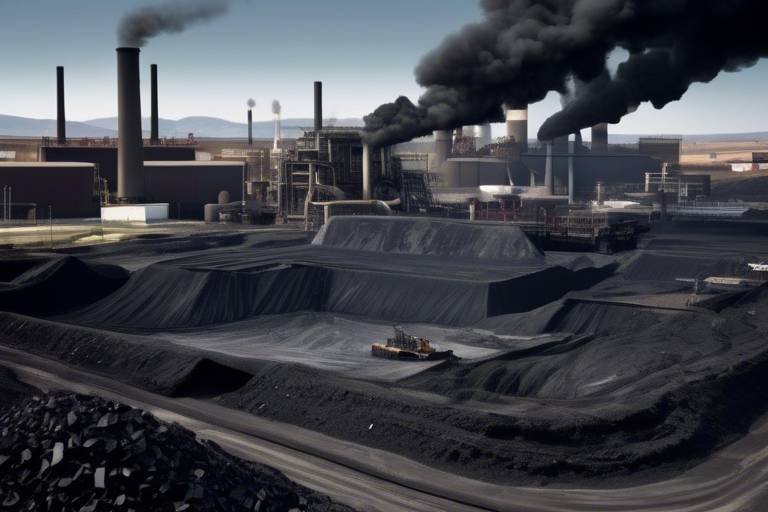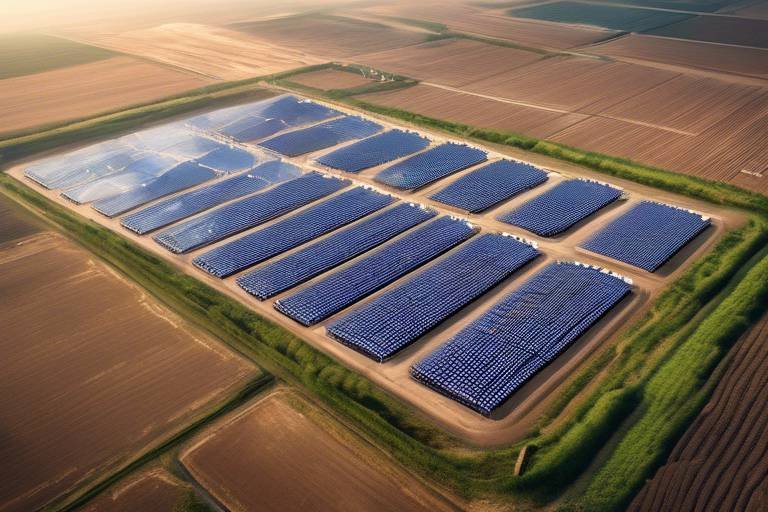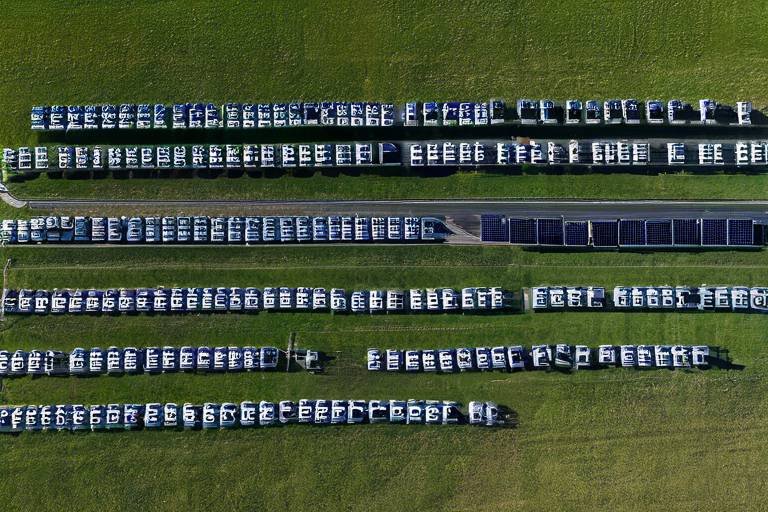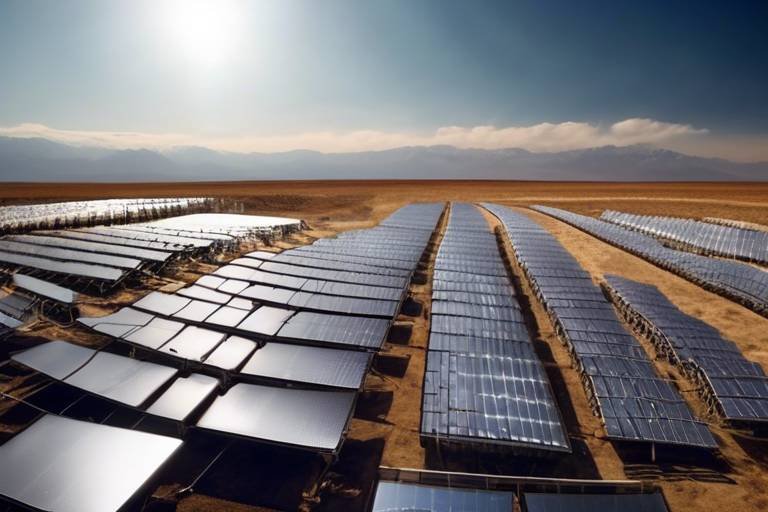Is Carbon Offsetting a Real Solution to Climate Change?
Climate change is one of the most pressing challenges of our time, and the urgency to address it has never been greater. As we witness extreme weather events and rising sea levels, the question arises: can carbon offsetting truly make a difference? Carbon offsetting has emerged as a popular strategy, allowing individuals and organizations to compensate for their carbon emissions by investing in projects that reduce greenhouse gases elsewhere. But is it a genuine solution or merely a way to ease our environmental conscience? Let's dive into this topic and explore the effectiveness of carbon offsetting as a tool for mitigating climate change.
At its core, carbon offsetting is about balancing out the carbon dioxide emissions produced by human activities, such as driving cars or using electricity. When someone offsets their carbon footprint, they invest in projects that either remove carbon from the atmosphere or prevent future emissions. This can include initiatives like planting trees, supporting renewable energy projects, or improving energy efficiency. But does throwing money at these projects actually lead to real change? Understanding the mechanics of carbon offsetting is crucial to grasping its potential and limitations.
Carbon offsetting projects come in various forms, each playing a unique role in the fight against climate change. Here are some main categories:
- Reforestation and Afforestation: Planting trees to absorb carbon dioxide.
- Renewable Energy: Investing in solar, wind, and hydroelectric power to reduce reliance on fossil fuels.
- Energy Efficiency: Enhancing energy use in buildings and industries to lower emissions.
Each of these initiatives contributes to a larger goal: reducing greenhouse gas emissions and promoting a more sustainable future.
Reforestation and afforestation are two of the most celebrated strategies in the realm of carbon offsetting. By planting trees, we not only sequester carbon dioxide but also restore ecosystems that provide habitat for countless species. Imagine a world where lush forests thrive, supporting biodiversity and combating climate change simultaneously! These projects serve as a dual solution, addressing both environmental degradation and carbon emissions.
However, it's not all sunshine and rainbows. Reforestation initiatives face significant challenges, such as land availability and the selection of appropriate species. For instance, planting the wrong type of tree in a particular ecosystem can lead to more harm than good. Additionally, land competition for agriculture or urban development can limit the areas available for reforestation. These obstacles can hinder the effectiveness of these projects, making it crucial to approach them with a strategic mindset.
Despite these challenges, there are inspiring success stories in afforestation that showcase the potential of these initiatives. For example, the Great Green Wall project in Africa aims to combat desertification by creating a mosaic of green across the continent. This ambitious initiative has not only helped to sequester carbon but has also improved local livelihoods and biodiversity. Such examples highlight the transformative power of well-executed afforestation projects.
Another critical aspect of carbon offsetting is investing in renewable energy projects. By harnessing the power of the sun, wind, and water, we can significantly reduce our dependence on fossil fuels. Think about it: every solar panel installed or wind turbine erected is a step towards a cleaner, more sustainable future. These projects not only lower emissions but also create jobs and stimulate local economies, making them a win-win for both the planet and communities.
So, how effective is carbon offsetting in reality? Evaluating its impact requires a closer look at various studies and reports. While some initiatives have shown promising results, others have fallen short of expectations. Is the glass half full or half empty? The answer often lies in the specifics of each project and how rigorously they are monitored and reported.
Accurate measurement of carbon offsets is essential for establishing credibility. Various methodologies exist to quantify emissions reductions, but transparency in reporting is crucial. If we can't trust the numbers, how can we trust the solutions? Ensuring that projects adhere to rigorous standards is vital for maintaining the integrity of carbon offsetting as a climate strategy.
Despite its growing popularity, carbon offsetting is not without its critics. Some argue that it can lead to greenwashing, where companies use offsets as a way to distract from their ongoing emissions. Others worry that it may undermine direct emissions reductions, allowing individuals and businesses to continue polluting while simply paying for offsets. These critiques highlight the need for a balanced approach that prioritizes genuine emissions reductions alongside offsetting efforts.
1. What is carbon offsetting?
Carbon offsetting involves compensating for carbon emissions by investing in projects that reduce or remove greenhouse gases from the atmosphere.
2. How do I offset my carbon footprint?
You can offset your carbon footprint by purchasing carbon credits from verified projects, such as reforestation or renewable energy initiatives.
3. Are all carbon offset projects effective?
Not all projects are created equal. The effectiveness of a carbon offset project depends on its implementation, monitoring, and adherence to rigorous standards.
4. Can carbon offsetting replace direct emissions reductions?
Carbon offsetting should complement, not replace, direct emissions reductions. It's essential to reduce emissions at the source while also investing in offsetting initiatives.

The Concept of Carbon Offsetting
Understanding carbon offsetting is crucial in our fight against climate change. At its core, carbon offsetting refers to the practice of compensating for the greenhouse gas emissions produced by individuals, companies, or organizations by investing in projects that reduce or capture an equivalent amount of carbon dioxide from the atmosphere. Think of it like this: if you can’t avoid making a mess, you might as well clean it up in another way. It’s a way to balance out our carbon footprint by supporting initiatives that promote environmental sustainability.
Individuals and organizations can engage in carbon offsetting through various initiatives. For example, if a company emits a certain amount of carbon dioxide through its operations, it can purchase carbon credits from projects that help reduce emissions elsewhere, such as renewable energy projects or reforestation efforts. This approach allows businesses to take responsibility for their environmental impact while still continuing their operations.
There are a few key components to understand when diving into carbon offsetting:
- Carbon Credits: These are certificates representing the reduction of one metric ton of carbon dioxide emissions. Purchasing these credits helps fund projects that reduce greenhouse gas emissions.
- Project Types: The projects supported through carbon offsetting can vary widely, from renewable energy to forest conservation. Each project type plays a unique role in combating climate change.
- Verification: For carbon offsetting to be effective, projects must be verified by independent third parties to ensure that they genuinely reduce emissions.
It’s also important to recognize that carbon offsetting is not a silver bullet for climate change. While it can play a significant role in reducing overall emissions, it should be seen as part of a broader strategy that includes reducing emissions at the source. In essence, offsetting is like putting a band-aid on a wound; it helps, but it’s not a substitute for addressing the underlying issue. The ultimate goal should always be to reduce emissions directly whenever possible, while using offsetting as a complementary tool.
In conclusion, carbon offsetting serves as a bridge in our transition toward a more sustainable future. It empowers individuals and organizations to take action, making it a vital component in the larger puzzle of combating climate change. By understanding the concept of carbon offsetting, we can better appreciate its role in our collective efforts to protect the planet.

Types of Carbon Offsetting Projects
When it comes to carbon offsetting, the variety of projects available is as diverse as the challenges we face in combating climate change. Each type of project plays a vital role in mitigating greenhouse gas emissions, and understanding these different initiatives can empower individuals and organizations to make informed decisions about their carbon footprints. Essentially, carbon offsetting projects can be categorized into three main types: reforestation, renewable energy, and energy efficiency projects. Each of these categories offers unique benefits and approaches to reducing carbon emissions.
Reforestation and afforestation are perhaps the most well-known forms of carbon offsetting. These projects focus on planting trees in deforested areas or creating new forests in previously barren land. Trees act as natural carbon sinks, absorbing carbon dioxide from the atmosphere and storing it in their biomass. This not only helps in reducing greenhouse gases but also restores ecosystems, enhances biodiversity, and improves soil quality. However, the effectiveness of these initiatives can be influenced by various factors, such as land availability and the selection of appropriate tree species for the local environment.
On the other hand, renewable energy initiatives encompass a wide range of projects aimed at harnessing energy from sustainable sources like solar, wind, and hydroelectric power. By investing in these technologies, we can significantly reduce our dependence on fossil fuels, which are major contributors to carbon emissions. For instance, a solar farm can generate clean energy while displacing the need for coal or natural gas, leading to a direct reduction in emissions. Furthermore, renewable energy projects often create jobs and stimulate local economies, making them a win-win solution for both the environment and communities.
Lastly, energy efficiency projects focus on reducing the amount of energy required to provide services and goods. This can involve upgrading buildings with better insulation, implementing energy-efficient appliances, or optimizing industrial processes. By enhancing energy efficiency, we can lower overall energy consumption, which in turn decreases the demand for energy production from fossil fuels. The beauty of energy efficiency is that it often pays for itself over time through reduced energy bills, making it an attractive option for both businesses and homeowners.
In summary, the types of carbon offsetting projects are varied, each contributing uniquely to the overarching goal of reducing carbon emissions. Whether it's through the planting of trees, the adoption of renewable energy sources, or improving energy efficiency, these initiatives are essential in the fight against climate change. As we explore these options, it's crucial to consider the local context and the specific needs of each community to ensure that our efforts are both effective and sustainable.

Reforestation and Afforestation
When we talk about reforestation and afforestation, we’re diving into two of the most impactful strategies for combating climate change. At their core, both practices involve planting trees, but they serve slightly different purposes. Reforestation refers to the process of replanting trees in areas where forests have been cut down or degraded, while afforestation involves planting trees in areas that have never been forested before. Think of it as giving Mother Nature a helping hand to restore her beauty and balance.
Why is this so important? Trees are nature’s lungs; they absorb carbon dioxide, one of the main greenhouse gases contributing to climate change. In fact, a mature tree can absorb about 48 pounds of CO2 per year. Imagine the impact if we could plant millions of trees! Not only do they help sequester carbon, but they also create habitats for wildlife, improve air quality, and enhance biodiversity. It’s a win-win situation! However, the journey of reforestation and afforestation is filled with challenges and triumphs that we must navigate.
One of the most significant benefits of these initiatives is their ability to restore ecosystems. Forests are crucial for maintaining the balance of our environment. They regulate water cycles, prevent soil erosion, and provide a habitat for countless species. By planting trees, we’re not just fighting climate change; we’re also fostering a healthier planet. To put it into perspective, consider this: a single tree can provide shelter for over 100 different species of birds and mammals. Isn’t that amazing?
However, it’s essential to acknowledge that reforestation and afforestation are not without their hurdles. For instance, the availability of land can be a significant barrier. In many regions, suitable land for planting is scarce due to urbanization or agricultural expansion. Moreover, selecting the right species to plant is crucial. Not all trees are created equal; some may thrive in certain environments while others may not. Planting the wrong species can lead to ecological imbalance, which is the exact opposite of what we want to achieve.
In summary, while reforestation and afforestation are powerful tools in our fight against climate change, they require careful planning and execution. We must ensure that we’re not just planting trees for the sake of it but are actively contributing to a sustainable and thriving ecosystem. The journey may be challenging, but the rewards—both for our planet and future generations—are well worth the effort.
- What is the difference between reforestation and afforestation?
Reforestation is the process of replanting trees in deforested areas, while afforestation involves planting trees in areas that have never had forests. - How do trees help combat climate change?
Trees absorb carbon dioxide, which helps reduce greenhouse gas levels in the atmosphere, thereby mitigating climate change. - What are some challenges faced in reforestation projects?
Challenges include land availability, species selection, and potential ecological imbalances.

Challenges in Reforestation
Reforestation is often hailed as a powerful tool in the fight against climate change, but it’s not without its challenges. One of the most pressing issues is the availability of suitable land. As urban areas expand and agriculture takes precedence, finding space to plant new trees becomes increasingly difficult. Furthermore, the land that is available may not always be appropriate for the types of trees we wish to plant, leading to a mismatch that can hinder the effectiveness of these projects.
Another significant challenge is species selection. Not every tree species is suitable for every environment. Planting non-native species can disrupt local ecosystems, leading to unintended consequences that might outweigh the benefits of carbon sequestration. It's crucial to choose trees that are not only effective at absorbing carbon but also native to the area, as they support local wildlife and contribute to biodiversity.
Additionally, the long-term maintenance of reforested areas is essential. Newly planted trees require care and protection from threats such as pests, diseases, and competition from invasive species. Without proper management, these young trees may struggle to survive, undermining the entire reforestation effort. This ongoing commitment often requires funding and resources that may not always be available.
Lastly, the social dynamics surrounding land use can complicate reforestation efforts. In many regions, land ownership is a contentious issue. Local communities may have different priorities, such as agricultural development or housing, which can clash with reforestation goals. Engaging with these communities and ensuring that they see the benefits of reforestation is vital for the success of any project.
In summary, while reforestation presents a promising avenue for offsetting carbon emissions, it is essential to navigate the challenges of land availability, species selection, maintenance, and social dynamics. Addressing these issues thoughtfully can enhance the effectiveness of reforestation efforts and contribute to a more sustainable future.
- What is reforestation? Reforestation is the process of planting trees in an area that has previously been deforested or degraded.
- Why is species selection important in reforestation? Choosing the right species ensures that the trees can thrive in their environment and support local ecosystems.
- What are some common challenges faced in reforestation? Challenges include land availability, species selection, long-term maintenance, and social dynamics involving local communities.
- How can communities benefit from reforestation projects? Reforestation can create jobs, improve air quality, and enhance biodiversity, providing both environmental and economic benefits.

Success Stories in Afforestation
Afforestation is not just a buzzword; it's a powerful tool in the fight against climate change, and there are numerous success stories that illustrate its potential. One standout example is the Great Green Wall initiative in Africa. This ambitious project aims to create a mosaic of green and productive landscapes across the Sahel region, stretching from Senegal to Djibouti. By planting millions of trees, this initiative not only combats desertification but also provides local communities with sustainable livelihoods. Imagine transforming barren land into lush forests that support biodiversity and improve air quality!
Another inspiring case is the Trillion Tree Campaign, which has mobilized individuals, organizations, and governments worldwide to plant trees. Since its inception, it has successfully led to the planting of billions of trees, showcasing the collective power of grassroots efforts. This campaign highlights how even small actions, like planting a single tree in your backyard, can contribute to a larger global movement. The ripple effect of these actions is profound, as each tree planted helps to sequester carbon and restore ecosystems.
In India, the Green India Mission has made remarkable strides in afforestation. Launched in 2010, this initiative aims to enhance ecosystem services, increase forest cover, and improve the livelihoods of forest-dependent communities. Through community participation and sustainable practices, millions of hectares have been reforested, demonstrating that when local communities are involved, the success rate skyrockets! The mission not only focuses on planting trees but also on restoring degraded forests, ensuring a holistic approach to environmental sustainability.
These success stories are more than just isolated achievements; they serve as beacons of hope and inspiration. They remind us that afforestation can lead to tangible benefits, such as improved air quality, enhanced biodiversity, and increased resilience to climate change. However, it's crucial to recognize that these initiatives require ongoing support and commitment. As we reflect on these successes, we must also consider the lessons learned and the importance of sustainable practices in future afforestation efforts.
Ultimately, these examples highlight that afforestation is a viable path toward a healthier planet. They encourage us to think globally while acting locally, understanding that every effort counts. So, whether you're an individual looking to plant a tree or a corporation aiming to offset your carbon footprint, remember that your actions can contribute to a greener future. Let's keep the momentum going and continue to share success stories that inspire others to join the cause!
- What is afforestation? Afforestation is the process of planting trees in an area where there was no previous tree cover, aiming to create new forests.
- How does afforestation help combat climate change? By absorbing carbon dioxide from the atmosphere, trees play a crucial role in reducing greenhouse gas emissions.
- Can individuals participate in afforestation projects? Absolutely! Individuals can join local initiatives or even start their own by planting trees in their communities.
- What are some challenges faced in afforestation? Challenges include land availability, species selection, and the need for ongoing maintenance and protection of newly planted areas.

Renewable Energy Initiatives
When we talk about carbon offsetting, one of the most impactful strategies involves investing in renewable energy initiatives. These projects are not just buzzwords; they represent a significant shift towards a more sustainable future, aiming to reduce our reliance on fossil fuels. Think of renewable energy as the cleaner sibling in the energy family—solar, wind, and hydroelectric power are all here to help us break free from the chains of carbon emissions. By harnessing the power of nature, we can generate electricity without the nasty byproducts that come from burning coal or gas.
Solar energy, for instance, is like capturing a piece of the sun and using it to power our homes and businesses. It’s becoming increasingly accessible, with solar panels popping up on rooftops everywhere. This transition not only helps in reducing greenhouse gas emissions but also creates jobs in manufacturing and installation, contributing to the economy. Wind energy, on the other hand, is about harnessing the power of the breeze. Wind farms, often located in open fields or offshore, can produce massive amounts of energy. The beauty of wind energy lies in its scalability—from small personal turbines to large wind farms, there’s potential for everyone to get involved.
Hydroelectric power is another key player in the renewable energy game. By utilizing the flow of rivers and streams, hydroelectric plants can generate electricity without releasing harmful emissions. However, it’s essential to consider the environmental impacts of damming rivers, as it can disrupt local ecosystems. Despite these concerns, when done responsibly, hydroelectric projects can provide a steady and reliable source of energy.
Investing in renewable energy initiatives not only helps in offsetting carbon emissions but also plays a critical role in the broader context of energy efficiency. By transitioning to cleaner energy sources, we can significantly lower our carbon footprint. Many organizations and individuals are now purchasing renewable energy credits (RECs) to offset their carbon emissions. This is where they pay for the generation of renewable energy, thereby supporting these initiatives even if they can't install solar panels or wind turbines themselves.
To give you a clearer picture, here’s a table that compares the carbon emissions associated with traditional energy sources versus renewable energy sources:
| Energy Source | Carbon Emissions (kg CO2/kWh) |
|---|---|
| Coal | 1.0 - 1.2 |
| Natural Gas | 0.4 - 0.6 |
| Solar | 0.05 - 0.1 |
| Wind | 0.01 - 0.02 |
| Hydroelectric | 0.02 - 0.04 |
This table highlights just how much cleaner renewable energy can be compared to traditional fossil fuels. The numbers speak for themselves, don’t they? By investing in renewable initiatives, we’re not just offsetting our emissions; we’re actively participating in a revolution that aims to create a sustainable planet for future generations.
In conclusion, renewable energy initiatives are a cornerstone of effective carbon offsetting strategies. They not only help mitigate climate change but also foster economic growth and energy independence. As we continue to explore innovative solutions to combat climate change, embracing renewable energy is a step we can all take towards a brighter, cleaner future.
- What is carbon offsetting? Carbon offsetting is a way to compensate for greenhouse gas emissions by investing in projects that reduce or capture an equivalent amount of emissions elsewhere.
- How do renewable energy initiatives work? Renewable energy initiatives involve generating energy from natural sources like the sun, wind, and water, reducing reliance on fossil fuels and lowering carbon emissions.
- Can I offset my carbon footprint? Yes, individuals can offset their carbon footprint by purchasing carbon credits or investing in renewable energy projects.
- Are renewable energy projects effective? Yes, studies show that renewable energy projects significantly reduce greenhouse gas emissions and contribute to sustainable development.

The Effectiveness of Carbon Offsetting
When it comes to tackling climate change, the effectiveness of carbon offsetting is a hot topic. Many people wonder if purchasing carbon offsets can truly make a difference or if it’s just a way for companies and individuals to feel good about their environmental impact without making substantial changes to their behavior. To truly understand the effectiveness of carbon offsetting, we need to dive into the evidence, the methodologies used for measuring offsets, and the criticisms that surround this practice.
Recent studies indicate that while carbon offsetting can play a role in reducing overall emissions, it is not a silver bullet. For example, a report from the Intergovernmental Panel on Climate Change (IPCC) highlights that offsetting alone cannot meet the ambitious targets set out in the Paris Agreement. Instead, it should be viewed as a complementary strategy to direct emissions reductions. This means that while carbon offsetting can help mitigate some of the impacts of unavoidable emissions, it should not replace efforts to cut down on emissions at the source.
To evaluate the real impact of carbon offsetting, various methodologies have been developed to quantify emissions reductions accurately. These methodologies often involve complex calculations, taking into account factors like project longevity, additionality (whether the project would have happened without the offset funding), and leakage (the risk that reducing emissions in one area might lead to increases elsewhere). Transparency in reporting is crucial here; without it, the credibility of carbon offsets can be called into question.
Moreover, the effectiveness of carbon offsetting projects can vary significantly based on their type. For instance, renewable energy projects tend to have a more immediate and measurable impact on reducing emissions compared to some reforestation projects, which may take years or decades to mature and sequester significant amounts of carbon. This leads to the question: how do we ensure that the offsets we invest in are genuinely effective?
One way to address this concern is through rigorous third-party verification processes, which can help ensure that projects are delivering on their promises. However, even with verification, critics argue that offsetting can sometimes create a false sense of security. The idea that one can simply buy their way out of responsibility for emissions can lead to complacency and a lack of motivation to change consumption habits.
In summary, while carbon offsetting can contribute to mitigating climate change, it is essential to approach it with a critical eye. It should be part of a broader strategy that includes direct emissions reductions, innovative technologies, and lifestyle changes. The effectiveness of carbon offsetting is not just about the numbers; it’s about fostering a culture of sustainability and accountability.
- What is carbon offsetting? Carbon offsetting is a method where individuals or organizations compensate for their carbon emissions by investing in projects that reduce or sequester carbon elsewhere.
- How do I know if a carbon offset project is legitimate? Look for projects that are verified by reputable third-party organizations and that provide transparent reporting on their emissions reductions.
- Can carbon offsetting replace direct emissions reductions? No, carbon offsetting should complement direct emissions reductions, not replace them. It’s essential to reduce emissions at the source.
- What types of projects are involved in carbon offsetting? Common projects include reforestation, renewable energy initiatives, and energy efficiency improvements.

Measuring Carbon Offsets
Accurate measurement of carbon offsets is essential for establishing credibility in the fight against climate change. When individuals and organizations invest in carbon offset projects, they need to ensure that the emissions reductions claimed are real, quantifiable, and verifiable. This is where rigorous methodologies come into play. Various international standards and protocols exist to guide the measurement of carbon offsets, ensuring that projects deliver on their promises. For instance, methodologies like the Verified Carbon Standard (VCS) and the Gold Standard provide frameworks for assessing the effectiveness of offset projects.
One of the primary methods used to measure carbon offsets is through baseline assessments. This involves determining the amount of carbon emissions that would have occurred in the absence of the project. By establishing a baseline, project developers can calculate the difference between expected emissions and actual emissions, which directly correlates to the amount of carbon offset achieved. Furthermore, it is crucial to incorporate monitoring and reporting mechanisms that regularly evaluate the performance of these projects. This ongoing assessment helps ensure that the claimed offsets are maintained over time.
Transparency in reporting is another vital component in measuring carbon offsets. Stakeholders, including investors and consumers, need access to clear and concise information regarding how offsets are calculated and verified. This transparency builds trust and encourages more participation in carbon offsetting initiatives. In many cases, third-party verification is employed to enhance credibility. Independent auditors assess projects to confirm that they meet the required standards for emissions reductions.
However, measuring carbon offsets is not without its challenges. Factors such as leakage, which refers to the unintended increase in emissions in another location due to the implementation of a project, can complicate assessments. Additionally, the longevity of carbon storage can vary, particularly in projects like reforestation, where trees may be vulnerable to disease, fire, or other natural disasters. Therefore, it is crucial for project developers to account for these variables when calculating offsets.
In summary, measuring carbon offsets is a multifaceted process that requires careful consideration of methodologies, transparency, and ongoing monitoring. As carbon offsetting continues to gain traction as a strategy for addressing climate change, the importance of robust measurement practices cannot be overstated. Only through accurate assessment can we ensure that our efforts are making a genuine impact on reducing greenhouse gas emissions.
- What are carbon offsets? Carbon offsets are reductions in greenhouse gas emissions, such as carbon dioxide, that are used to compensate for emissions produced elsewhere.
- How are carbon offsets measured? They are measured through baseline assessments, monitoring, reporting, and third-party verification to ensure accuracy and credibility.
- What is leakage in carbon offsetting? Leakage refers to the situation where emissions are not reduced but instead increased in another location due to the implementation of a carbon offset project.
- Why is transparency important in carbon offsetting? Transparency builds trust among stakeholders and ensures that the claimed emissions reductions are credible and verifiable.

Critiques of Carbon Offsetting
While carbon offsetting has gained traction as a method to combat climate change, it is not without its fair share of critiques. One of the most significant concerns is the issue of greenwashing. This term refers to the practice where companies promote themselves as environmentally friendly while continuing to engage in harmful practices. Critics argue that purchasing carbon offsets can give organizations a false sense of security, allowing them to maintain their carbon-intensive operations without making the necessary changes to reduce their emissions directly.
Another major critique revolves around the effectiveness of carbon offsetting projects. Many skeptics question whether these initiatives truly deliver on their promises. For instance, not all projects are created equal; some may not sequester as much carbon as claimed, or they might fail to deliver long-term benefits. This discrepancy raises critical questions about the credibility of offset projects and the methodologies used to measure their impacts. Without rigorous standards and transparency, it’s challenging to ascertain whether the money spent on offsets is genuinely contributing to the fight against climate change.
Moreover, there is a concern that carbon offsetting could potentially undermine direct emissions reductions. If individuals and organizations rely too heavily on offsets, they might neglect the more crucial step of reducing their own carbon footprints. This reliance can create a dangerous complacency, where the focus shifts from necessary systemic changes to a "pay-to-pollute" mentality. Essentially, the argument is that while offsets can play a role in a broader strategy for sustainability, they should not be seen as a substitute for genuine emissions reductions.
Additionally, the social equity aspect of carbon offsetting cannot be overlooked. Many offset projects are located in developing countries, where local communities may not benefit from the financial investments made by foreign companies. This can lead to a situation where the environmental benefits are realized, but the social costs are borne by vulnerable populations. It raises ethical questions about who gets to decide where and how offsets are implemented and who ultimately reaps the rewards.
In summary, while carbon offsetting can be a useful tool in the fight against climate change, it is essential to approach it with a critical eye. The critiques highlight the need for transparency, accountability, and a commitment to direct emissions reductions. As we navigate the complexities of climate action, it is crucial to ensure that offsetting complements, rather than replaces, the necessary steps toward a sustainable future.
- What is carbon offsetting? Carbon offsetting is a method used to compensate for carbon emissions by funding projects aimed at reducing greenhouse gases, such as reforestation or renewable energy initiatives.
- Why is carbon offsetting controversial? It is controversial due to concerns about greenwashing, the effectiveness of projects, potential neglect of direct emissions reductions, and social equity issues.
- Can carbon offsetting replace direct emissions reductions? No, while it can help mitigate emissions, it should not be seen as a substitute for necessary reductions in carbon footprints.
Frequently Asked Questions
- What is carbon offsetting?
Carbon offsetting is a way for individuals and organizations to compensate for their carbon emissions by investing in projects that reduce or remove carbon dioxide from the atmosphere. This can include initiatives like reforestation, renewable energy, and energy efficiency projects.
- How do carbon offsetting projects work?
Carbon offsetting projects work by measuring the amount of carbon dioxide that can be reduced or sequestered through specific initiatives. For example, planting trees can absorb CO2, while renewable energy projects can replace fossil fuel energy sources, leading to lower overall emissions.
- Are all carbon offsetting projects effective?
No, not all carbon offsetting projects are equally effective. The success of a project depends on various factors, including the methodology used to measure carbon offsets, the project's longevity, and its ability to deliver genuine emissions reductions.
- What are the main types of carbon offsetting projects?
The main types of carbon offsetting projects include reforestation and afforestation, renewable energy initiatives, and energy efficiency projects. Each type plays a unique role in mitigating climate change and reducing greenhouse gas emissions.
- What challenges do reforestation projects face?
Reforestation projects can face challenges such as land availability, proper species selection, and ensuring the long-term survival of planted trees. These factors can significantly impact the effectiveness of such initiatives in sequestering carbon.
- Can carbon offsetting lead to greenwashing?
Yes, carbon offsetting can lead to greenwashing, where companies claim to be environmentally friendly while continuing harmful practices. It's essential for consumers to research and ensure that the offsetting projects they support are credible and genuinely effective.
- How can I measure the effectiveness of carbon offsets?
The effectiveness of carbon offsets can be measured through various methodologies that quantify emissions reductions. Transparency in reporting and third-party verification are crucial for ensuring the credibility of carbon offsetting claims.
- What are some successful examples of afforestation?
Successful afforestation projects include large-scale tree-planting initiatives in countries like China and India, which have significantly contributed to carbon offsetting and environmental restoration, showcasing the potential positive impact of such efforts.



















